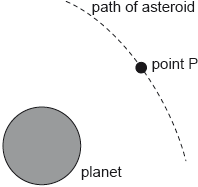| Date | May 2021 | Marks available | 2 | Reference code | 21M.2.HL.TZ2.3 |
| Level | Higher level | Paper | Paper 2 | Time zone | 2 |
| Command term | Outline | Question number | 3 | Adapted from | N/A |
Question
A vertical wall carries a uniform positive charge on its surface. This produces a uniform horizontal electric field perpendicular to the wall. A small, positively-charged ball is suspended in equilibrium from the vertical wall by a thread of negligible mass.
The centre of the ball, still carrying a charge of 1.2 × 10−6 C, is now placed 0.40 m from a point charge Q. The charge on the ball acts as a point charge at the centre of the ball.
P is the point on the line joining the charges where the electric field strength is zero. The distance PQ is 0.22 m.
The charge per unit area on the surface of the wall is σ. It can be shown that the electric field strength E due to the charge on the wall is given by the equation
.
Demonstrate that the units of the quantities in this equation are consistent.
The thread makes an angle of 30° with the vertical wall. The ball has a mass of 0.025 kg.
Determine the horizontal force that acts on the ball.
The charge on the ball is 1.2 × 10−6 C. Determine σ.
The thread breaks. Explain the initial subsequent motion of the ball.
Calculate the charge on Q. State your answer to an appropriate number of significant figures.
Outline, without calculation, whether or not the electric potential at P is zero.
Markscheme
identifies units of as ✓
seen and reduced to ✓
Accept any analysis (eg dimensional) that yields answer correctly
horizontal force on ball ✓
✓
✓
Allow g = 10 N kg−1
Award [3] marks for a bald correct answer.
Award [1max] for an answer of zero, interpreting that the horizontal force refers to the horizontal component of the net force.
✓
✓
Allow ECF from the calculated F in (b)(i)
Award [2] for a bald correct answer.
horizontal/repulsive force and vertical force/pull of gravity act on the ball ✓
so ball has constant acceleration/constant net force ✓
motion is in a straight line ✓
at 30° to vertical away from wall/along original line of thread ✓
✓
✓
2sf ✓
Do not award MP2 if charge is negative
Any answer given to 2 sig figs scores MP3
work must be done to move a «positive» charge from infinity to P «as both charges are positive»
OR
reference to both potentials positive and added
OR
identifies field as gradient of potential and with zero value ✓
therefore, point P is at a positive / non-zero potential ✓
Award [0] for bald answer that P has non-zero potential


